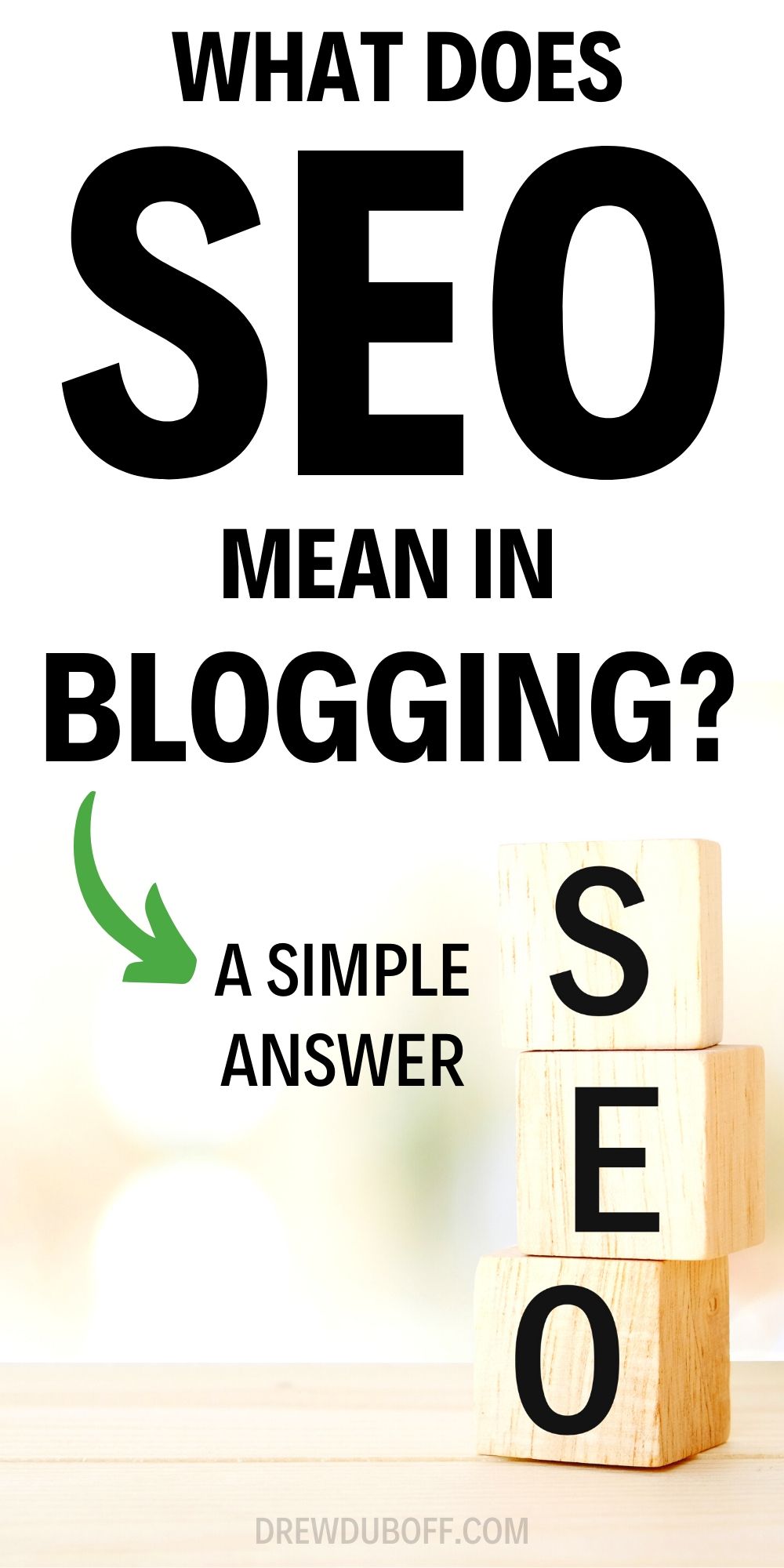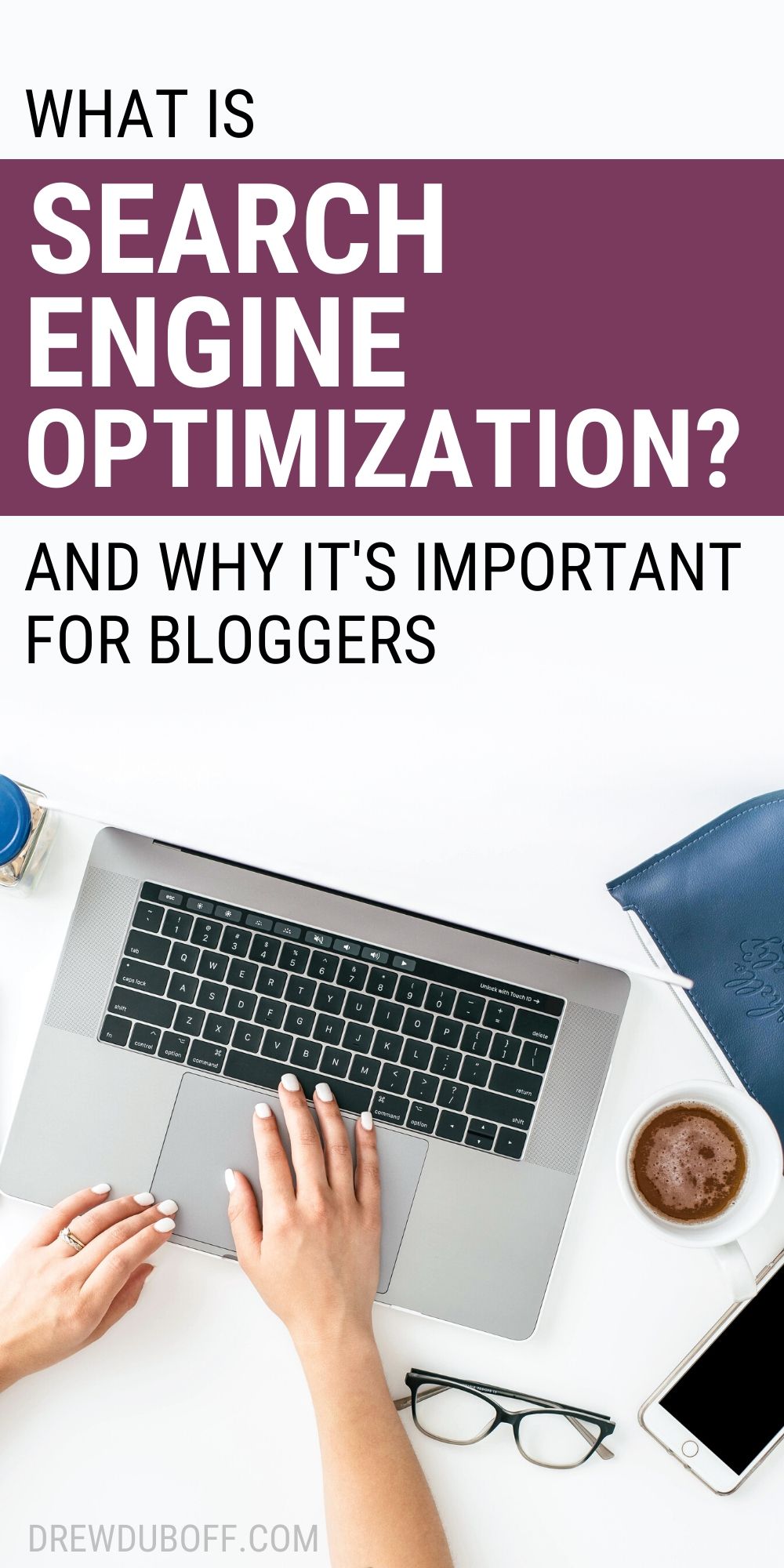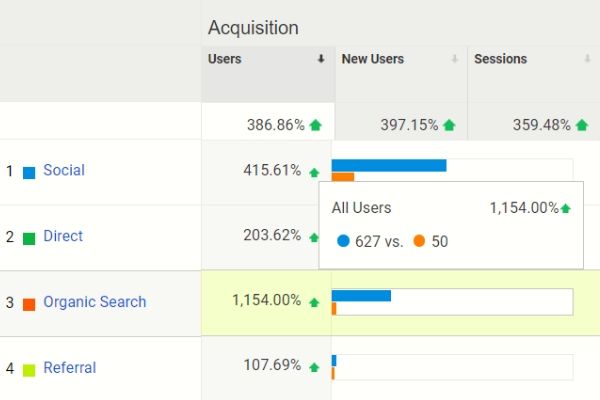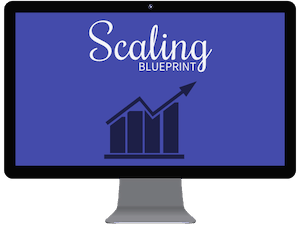When I first started blogging, there was one question I had that took a long time to get an answer (and when I got the answer, it never seemed to be the same according to different people).
That question was…
What does SEO mean in blogging?
SEO stands for Search Engine Optimization. In blogging, SEO means optimizing your blog posts to show up at a higher position in the SERPs (Search Engine Results Pages), which is influenced by on-page and off-page SEO. To get organic traffic, your blog needs to rank highly for keywords that relate to your niche.
But, I know that can be confusing!
Especially if you don’t know what the terms SEO and SERP mean…and the same goes for off-page SEO and on-page SEO.
It took me a LONG time to understand that terminology so I completely understand if it feels like your brain is exploding right now.
Don’t worry!
I’m going to simplify all of this with words that you don’t need to have an advanced SEO background to understand.
In this article, we’ll be discussing:
- What is SEO and how does it work?
- How to do SEO
- What is SEO in blogging?
- Does blogging help with SEO?
- How to Optimize Blog Posts for SEO
- How do I post an SEO blog?
- How long should blogs be for SEO?
- Blog SEO checklist
- Does SEO work?
- How often should a business blog?
- How often should you publish a blog?
Let’s get started!

What is SEO and How Does It Work?
SEO is the process of optimizing your blog posts to get organic, or unpaid, traffic from Google.
Technically, it also extends to other search engines, but the majority of the organic traffic you’ll get will come from Google.
Search engines function as an information retrieval service.
By that, I mean that when you type a question into Google’s search bar, it:
- Scans its index of content quickly
- Finds webpages that accurately describe and answer your query
- Lists them in an order of theoretical helpfulness
That’s the gist of how search engines work!
So, in terms of how it works from a blogging and content creator perspective, you simply have to optimize your content so that Google can recognize that your content answers a user’s query.
Remember…
Google wants its users to continue to use the platform, so it’s to Google’s advantage to serve up relevant content. That’s why the results pages will change over time as newer, helpful resources are created.
In other words, SEO is NOT dead!
But, you might be wondering:
- How to do SEO
- What is SEO in blogging?
- Does blogging help with SEO?
Let’s explore those a little more!
How to Do SEO
SEO is mainly a process of:
- On-Page SEO
- Off-Page SEO
On-Page SEO refers to what you’re doing on the actual webpage itself.
So, that includes:
- The content that you’ve created
- The interlinking structure
- How you’re organizing your content from a structural perspective
- The keywords you’re optimizing for, including the LSI keywords (related keywords, like “Tour the Empire State Building” for “Travel to New York”)
And more!
We’ll go into that a little later when I list my blog SEO checklist.
Off-Page SEO refers to what you’re doing outside of the webpage.
So, that includes:
- Your backlink strategy (when others link out to your content)
- Brand mentions (when you get featured in media outlets)
- Social signals (think of heavy Pinterest traffic as a signal the article’s important)
And, more!
SEO is the process of balancing both your on-page SEO and off-page SEO efforts to position your blog posts to be ranked more frequently and more highly.
What is SEO in Blogging?
SEO in blogging is generally considered to be a traffic strategy that you tackle after you’re three to six months in on your blogging journey. It’s NOT something you need to do off-the-bat and I wouldn’t recommend it.
SEO traffic is highly coveted because it typically:
- Comes with a lower bounce rate (how frequently and quickly people leave your webpage)
- Means users are more targeted, so you can get more affiliate conversions
- Is required for you to get approved into an advertising network like Mediavine
But, as I said, don’t focus on it initially.
I definitely didn’t!
You’ll get SO worked up in how to do SEO that you forget to actually be a blogger.
SEO is a long-term game, so you still need to be blogging to see results from SEO.
If you get burned out and want to stop blogging, then SEO traffic really won’t help you at all.
So, take a course like Stupid Simple SEO when you’re about three to six months into blogging and you won’t regret it!
Does Blogging Help With SEO?
Yes, blogging does help with SEO!
For one, when you publish new blog posts, you’re encouraging Google to crawl (send its invisible bots) to check out your new content.
That means that Google’s keeping tabs on your content.
I always submit new content to Google Search Console to alert it I have new content, but that’s not necessary. However, I would encourage it, in the beginning, to get Google in the habit of checking out your content.
To do that, you just have to:
- Log into your account
- Inspect the URL with the bar at the top
- Follow the process Google outlines
Now, there are some rogue cases of people who create a lot of content initially and then build a lot of backlinks afterward and they still get SEO traffic, but I wouldn’t recommend that as a beginner strategy.
Someone who does that is Mike Pearson, but he’s an SEO unicorn and unlike you and me.
For right now, focus on:
- Blogging consistently
- Creating good content
- Getting Pinterest traffic to kickstart your SEO efforts
You will naturally do some SEO best practices without even realizing it!

How to Optimize Blog Posts for SEO
When you optimize blog posts for SEO, you’re doing your best to create a blog post that:
- Solves a reader’s problem or answers their question
- Is logical and easy to read and follow
- Helps readers achieve or understand what they want to
Consider SEO optimization more as helping out a friend and guiding them to success than anything technical.
Google has phased out practices of keyword stuffing and over-optimizing your content, so really, it’s not about how often you stick your keyword in an article to get Google’s attention, but what their readers get out of it.
If you want to know how to optimize blog posts for SEO, then we need to consider the following:
- How do I post an SEO blog?
- How long should blogs be for SEO?
- Is there a blog SEO checklist?
Let’s explore these a little more!
How Do I Post an SEO Blog?
Posting an SEO blog isn’t any more formal than posting a regular blog.
If you use WordPress like I do, then you’ll just want to:
- Go to “Posts”
- Click on “Add New”
- Type in your post
- Hit “Publish”
It’s not a fancy process at all!
Now, I would recommend doing a couple of things like optimizing your:
- Title
- Meta description (what you encourage Google to use as a snippet in results)
- Slug (the extension in the URL of your blog post after .com/)
But, we’ll get into the full on-page SEO process a little later.
How Long Should Blogs Be for SEO?
This question actually has a more scientific answer.
And, I love data when it comes to blogging because so much of it is NOT scientific-based.
The average length for a blog post that ranks #1 on Google is about 1,890 words. But, this does not mean that you should optimize your blog posts to be that length.
There are other considerations.
For example:
- How long is your competition’s article? (Could be much shorter or much longer!)
- How long does it really take to answer the question without fluff or BS?
As you can see, there are many variables.
But, whenever I encounter bloggers who ask the question of how long blog posts need to be for SEO, I typically say as long as the post needs to be to effectively and helpfully answer the intent of the search query.
Don’t try and add in additional content that ups the word count and doesn’t function as anything helpful.
But, if you are struggling with lengthening an article, consider an FAQ section.
I did that with my article titled “Do You Need an LLC for Your Blog? And How to Form One” because I thought it was important to address all the additional questions users might have.
To HELP them.
Let your helpfulness dictate the length.
Blog SEO Checklist
You’re lucky because I typically only give this SEO checklist out to my coaching clients.
To optimize your blog posts for SEO, use this checklist:
- Understand the user/searcher intent
- Use the main keyword in the post title, preferably more toward the beginning. My headlines are typically a 70 or higher on the CoSchedule Headline Analyzer tool
- Keep the URL short and sweet and only change the permalink if absolutely necessary. Do a 301 redirect in that case
- Write a click-worthy meta description
- Sprinkle LSI (latent semantic indexing) keywords throughout the post
- Use internal links (at least 2) to link to relevant posts on your site. These should open in the same browsing window
- Link to authoritative websites in your niche. These should open in a new window and by doing this, it puts you in a “neighborhood” that helps Google understand your site
- Optimize your images’ titles and alt text for the keyword
- Create an epic piece of content that is better than the competition’s
- Format the post with H2 and H3 tags and with short paragraphs
Definitely make sure you review this before you hit publish on a new blog post!

Does SEO Work?
Yes, SEO does work!
It requires some effort and discipline, but you can absolutely see results.
I’ve seen a significant 1,000% increase in my Google traffic over the course of a year thanks to Stupid Simple SEO!
As seen below :
(The date range is missing, but it’s comparing December 2019 traffic to February 2019 traffic, when I started publishing more content)

But, I can’t stress enough that SEO is largely a long-term game.
Don’t expect to get results in the short-term or you’ll get seriously disappointed.
Especially for newer blogs!
It can take 6 to 12 months to get out of the Google “sandbox” to the point where Google starts ranking your content.
So, please don’t be discouraged if you think your SEO efforts aren’t working. Of course, if you’re doing SEO wrong, you won’t see a benefit, so you make sure you take this SEO course to see real results.
But, in order for SEO to work, I do want to discuss two concepts:
- How often should a business blog?
- How often should you publish a blog?
Let’s explore these a little more!
How Often Should a Business Blog?
A business should blog at a minimum of once a week to see real SEO results.
But, you do need more content initially to build up a repository for Google to rank.
So, what does that look like?
Well, I consider it a mad dash to 100,000 words, or 50 blog posts that are roughly 2,000 words a pop.
I think there’s something magical that happens at that stage.
If you need help creating content quickly, then check out an affordable eBook called Content is King. It’s what helps me to write speedily and publish blog posts in about 2 hours tops (in fact, this one will only take me an hour and a quarter and you see how long it is).
But, I think that to get Pinterest traffic, you really need 100 posts as Pinterest will really only favor about 20% of your content.
If you can swing two to three posts per week that are quality, then go for it!
If one is your maximum, then stick to that.
It’s better to put out quality than quantity.
How Often Should You Publish a Blog?
You should publish blog posts as soon as you’re done writing them!
Honestly…
There’s NO reason for you to schedule out content unless you have a recurring series where you drip content like an interview or a podcast each week at a certain time.
But, for Google, because it takes 6 to 12 months (and sometimes, even longer) to see an article’s potential be realized on the SERPs, you really want to publish that blog post as soon as possible.
There’s no point in waiting!
If you’re concerned about promotion, what I do is I:
- Publish the blog post
- Submit it to Google Search Console
- Schedule to share it in my Facebook group
I may not start sharing it on Pinterest until my audience has seen it, but for Google traffic, publish the content as soon as you can.

Conclusion
I hope you have a solid foundational understanding of SEO right now!
Of course, you can always further that education with my favorite SEO eBooks and eCourses. Those are what I used to increase my organic traffic by over 1000% this past year!
Here they are:
- Stupid Simple SEO
- Easy Backlinks for SEO
- Easy On-Page SEO
- Bundle of Easy Backlinks for SEO and Easy On-Page SEO
I promise these products work and they are SO worth the costs, especially when you factor in how much money you can get from the avalanche of traffic that comes your way.
Just to quickly recap, in this article, we discussed the overarching question of “What does SEO mean in blogging?” which includes:
- What is SEO and how does it work?
- How to do SEO
- What is SEO in blogging?
- Does blogging help with SEO?
- How to Optimize Blog Posts for SEO
- How do I post an SEO blog?
- How long should blogs be for SEO?
- Blog SEO checklist
- Does SEO work?
- How often should a business blog?
- How often should you publish a blog?
Do you have any outstanding SEO questions I can answer?
Let me know in the comments below 🙂
And, don’t forget to check out Stupid Simple SEO!
Cheers to your SEO success!








Thank you very much for telling all this, there is really a lot of information in this article which is very beneficial, I am very happy to read the article, it was such a good article that I shared it with my friends too, I hope that everyone must have enjoyed this article like I enjoyed, dear article author you should make such beneficial and beautiful article for us, it helps us a lot, thank you very much.
You’re welcome!